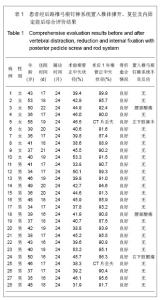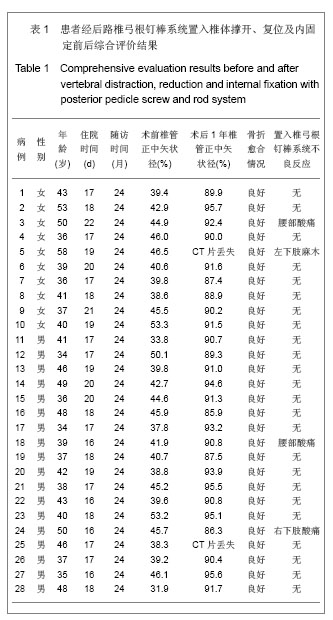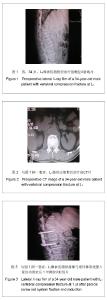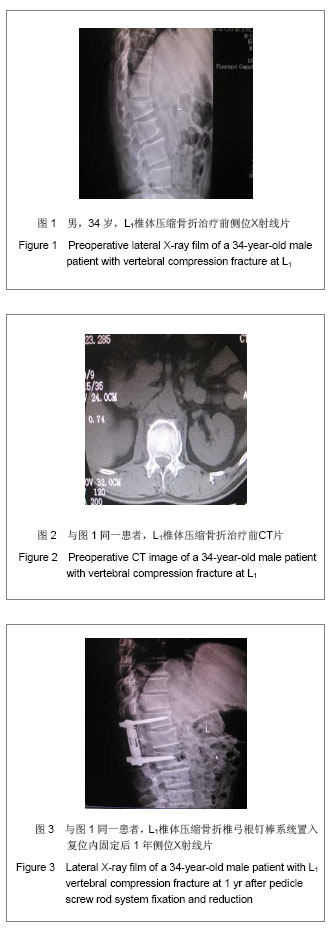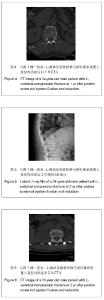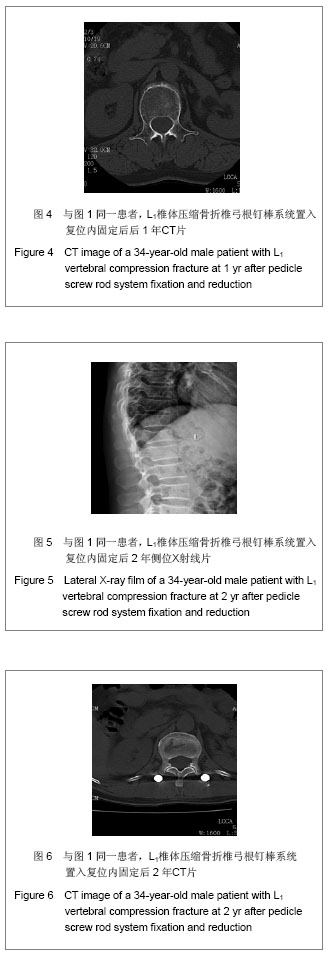| [1]Erturer E,Tezer M,Ozturk I,et al. Evaluation of vertebral fractures and associated injuries in adults .Acta OrthoP Traumatol Turc.2005;39(5):387-390.[2]Reinhold M,Knop C,Lange U,et al.Non-operative treatment of thoracolumbar spinal fraetures.Long-term clinical results over-16years.Unfallehirurg.2003;106(7):566-576.[3]Roy-Camille R,Saillant G, Mazel C.Plating of thoracic,thoracolumbar,and lumbar injuries with Pedicle screw plates.Orthop Clin North Am.1986;17:147-159.[4]Flamme CH,Hurschler C,Heymann C,et al.Comparative biomechanical testing Of anterior and posterior stabilization procedures.SPine.2005;30(13):352-362.[5]Ye LL,Xu NY.Zhonghua Chuangshang Guke Zazhi 2003;5(3): 260-261.叶毓麟,徐尼亚.后路减压加短节段椎弓根螺钉系统内固定治疗胸腰椎骨折并脊髓损伤[J].中华创伤骨科杂志,2003,5(3): 260-261.[6]Du XR,Zhao LX,Shi JC, et al.Zhongguo Linchuang Jiepouxue Zazhi.2007;25(3):239-242.杜心如,赵玲秀,石继川,等.经伤椎椎弓根螺钉复位治疗胸腰椎爆裂骨折的临床解剖学研究[J],中国临床解剖学杂志,2007,25(3): 239-242.[7]Fredrickson BE, Mann KA, Yuan HA, et al.Reduction of the intracanal fragment in experimental burst fractures. Spine. 1988;13: 267- 271.[8]Gertzbein SD, Crowe PJ, Fazl M, et al. Canal clearance in burst fractures using the AO internal fixator. Spine.1992;17: 558-560.[9]De Klerk LW, Fontijne WP, Stijnen T, et al. Spontaneous remodeling of the spinal canal after conservative management of thoracolumbar burst fractures. Spine;1998, 23: 1057- 1060.[10]Li Q,He XJ,Wang B, et al.Zhongguo Jizhu Jisui Zazhi.2007; 17(6):430-432.历强,贺西京,王斌,等,骨折内固定术后椎弓根螺钉断裂的原因分析及对策[J],中国脊柱脊髓杂志,2007,17(6):430-432.[11]AneksteinY,BroshT,Mirovsky Y.Intermediate screws in short segment pedicular fixation for thoracic and lumbar fractures: a biomechanical study. Spinal Disord Tech.2007; 20(1):72-77.[12]Potter BK,Lehman RA,Kuklo TR.Anatomy and Biomechanics of thoracic pedical screw instrumentation. Orthop; 2004,3: 133-144.[13]Reid DC, Hu R, Davis LA, et al. The nonoprative treatment of burst fractures of the thoracolumbar junction. J Trauma.1988;28:1188- 1194.[14]Zhou DZ,Li SF,Xiong C.Jingyaotong Zazhi. 2012;33(6):472-474.周道政,李世芳,熊灿. 两种治疗胸腰椎爆裂性骨折手术的疗效比较[J].颈腰痛杂志,2012,33(6):472-474. [15]Zhao B,Wang JF,Liang HW,et al.Baiqiuen Junyixueyuan Xuebao. 2012;10(5):404-405.赵斌,王剑锋,梁宏伟,等.椎弓根钉棒系统治疗胸腰椎骨折脱位56例[J]. 白求恩军医学院学报,2012,10(5):404-405.[16]Pu CC,Ran XJ,Deng CQ,et al.Linchuang Guke Zazhi. 2012; 15(5):490-491,494.蒲川成,冉学军,邓长青,等.椎弓根钉棒系统治疗胸腰段椎体骨折术后松动断裂的原因及防治[J].临床骨科杂志,2012,15(5): 490-491,494. [17]Yu Y,Fan HQ,Chen M,et al.Jizhu Waike Zazhi. 2012;10(4): 228-231.俞阳,范海泉,陈铭,等.经伤椎和跨伤椎椎弓根钉棒系统内固定治疗胸腰椎骨折[J].脊柱外科杂志,2012,10(4):228-231. [18]Gao XF.Zhongguo Zhongxiyi Jiehe Waike Zazhi. 2012;(4):416-417.高学峰.椎弓根钉棒非融合固定失败5例[J]. 中国中西医结合外科杂志,2012,(4):416-417. [19]Cai FJ,Zhu JP,Luo YC,et al.Zhongguo Zuzhi Gongcheng Yanjiu yu Linchuang Kangfu. 2012;16(30):5676-5680.蔡福金,朱建平,骆宇春,等. 经椎旁肌间隙入路椎弓根钉棒系统置入内固定治疗胸腰椎爆裂骨折:与传统方法比较[J]. 中国组织工程研究,2012,16(30):5676-5680.[20]Wang ZJ.Bengbu Yixueyuan Xuebao. 2012;37(8):950-952.汪正节.经后路椎弓根钉棒系统内固定治疗胸腰椎骨折的疗效观察[J].蚌埠医学院学报,2012,37(8):950-952. [21]Li KZ,Wang X,Yang WH,et al.Shengwu Guke Cailiao yu Linchuang Yanjiu. 2012;(4):63-64.李魁章,王鑫,杨伟华,等.椎弓根钉棒系统固定加椎间植骨治疗胸腰椎骨折[J]. 生物骨科材料与临床研究,2012,(4):63-64.[22]Tan YG.Zhongguo Yiyao Zhinan. 2012;10(15):49-50.谭祐光.后路钉棒系统治疗86例胸腰椎骨折及脱位的疗效分析[J]. 中国医药指南,2012,10(15):49-50. [23]Wen KS,Jiang B,Cai YP,et al.Zhongqing Yixue. 2012;41(15): 1496-1498.文坤树,蒋波,蔡勇平,等.椎弓根钉棒系统治疗胸、腰椎骨折56例体会[J].重庆医学,2012,41(15):1496-1498. [24]Chen XL,Shang P,Wen YF,et al.Zhongguo Xiandai Yiyao Zazhi. 2012;14(3):30-33.陈晓陇,尚平,温月凤,等.后路肌间隙入路在治疗胸腰椎疾患中的应用[J].中国现代医药杂志,2012,14(3):30-33. [25]Gu HC,Tang ZJ,Ye GY.Zhongguo Yiyao Zhinan. 2012;10(9): 168-170.顾海潮,唐镇江,叶国裕.后路椎弓根钉-棒系和AF钉治疗胸腰椎爆裂性骨折手术体会[J].中国医药指南,2012,10(9):168-170.[26]Yin ZM.Zhongguo Jiaoxing Waike Zazhi. 2012;20(4):369- 371.尹占民.经伤椎椎弓根椎体内植骨结合短节段钉棒系统内固定治疗胸腰椎爆裂性骨折37例分析[J].中国矫形外科杂志,2012, 20(4):369-371. [27]Hu M,Feng MM,Huang FS,et al.Zhongguo Guzhi Shusong Zazhi. 2011;17(10):899-902.胡明,冯孟明,黄凤山,等.椎体成形联合椎弓根钉棒系统治疗中老年骨质疏松性胸腰椎骨折[J].中国骨质疏松杂志,2011,17(10): 899-902.[28]Sun ZG,Yi XB,Lin FH,et al.Zhongguo Yiyao Zhinan. 2011; 9(32):5-6.孙志刚,易小波,蔺福辉,等.后路椎体次全切除并钛网支撑椎弓根钉棒系统内固定治疗胸腰椎爆裂骨折疗效观察[J].中国医药指南,2011,9(32):5-6. [29]Lin FH,Ren ZH.Zhongguo Wuzhenxue Zazhi. 2011;11(25): 6219-9220.蔺福辉,任志宏. 经皮椎弓根钉棒系统治疗胸腰椎骨折76例并发症分析[J].中国误诊学杂志,2011,11(25):6219-9220.[30]Song QW,Ji SQ,Ye ZF.Shandong Yiyao. 2011;51(28):79-80.宋庆伟,纪树青,岳志丰.椎弓根钉棒系统固定治疗胸腰椎骨折疗效观察[J].山东医药,2011,51(28):79-80.[31]Lv XF.Kunming Yixueyuan Xuebao. 2011;32(6):160-172.吕晓峰.后路椎弓根钉棒系统治疗胸腰椎骨折106例临床分析[J]. 昆明医学院学报,2011,32(6):160-172. [32]Cui WJ,Yang JF,Wang DM.Jilin Yixue. 2011;32(16): 3294- 3295.崔文军,杨金峰,王道明.椎弓根钉棒系统治疗严重胸腰椎骨折脱位[J].吉林医学,2011,32(16):3294-3295. [33]Hu XD.Jilin Yixue. 2011;32(6):1166-1167.胡晓东.34例胸腰椎骨折的椎弓根钉棒系统内固定治疗方法的效果探讨[J].吉林医学,2011,32(6):1166-1167. [34]Mau YW,Wei W,Huang CK,et al.Guangxi Yixue. 2011; 33(8): 1026-1027.麦荫文,韦文,黄承夸,等.经后路椎弓根钉棒系统内固定治疗胸腰椎骨折的疗效观察[J].广西医学,2011,33(8):1026-1027. [35]Deng ZB,Xie HB,Nashun DL,et al.Linchuang he Shiyan Yixue Zazhi. 2010;9(24):1869-1870.邓振博,谢红兵,那顺达来,等.后路椎弓根钉-棒系统内固定治疗胸腰椎爆裂骨折[J].临床和实验医学杂志, 2010,9(24):1869- 1870.[36]Jin SL,Zhou Y,Wang H,et al.Linchuang Guke Zazhi. 2010; 13(5):503-505.金绍林,周云,王辉,等.后路椎弓根钉棒系统短节段固定融合治疗胸腰椎爆裂性骨折[J].临床骨科杂志,2010,13(5):503-505. [37]Ren ZH,Yi XB,Lin FH,et al.Hebai Yiyao. 2010;32(14):1911- 1912.任志宏,易小波,蔺福辉,等.椎弓根钉棒系统治疗胸腰椎骨折的疗效及并发症分析[J]. 河北医药,2010,32(14):1911-1912.[38]Peng YL,Zhang ZH,Wu XH,et al.Xibu Yixue. 2010;22(8): 1397-1400.彭亦良,张泽华,吴雪辉,等.椎弓根钉棒系统固定治疗胸腰椎骨折的临床观察[J].西部医学,2010,22(8):1397-1400. [39]Qi ZT.Shandong Yiyao. 2010;50(26):97-98.齐志亭.椎弓根钉棒系统治疗胸腰椎不稳定骨折23例临床观察[J].山东医药,2010,50(26):97-98. [40]Yang DY.Zhongguo Yiyao Zhinan. 2010;8(23):33-35.杨德勇.椎弓根钉棒系统内固定治疗胸腰椎爆裂性骨折临床观察36例[J].中国医药指南,2010,8(23):33-35.[41]Li GL,Sun J,Li YX,et al.Shengwu Guke Cailiao yu Linchuang Yanjiu. 2009;6(5):55-56.李公伦,孙杰,李银喜,等.经后路椎弓根钉棒系统治疗胸腰椎爆裂骨折并脊髓损伤的临床研究[J].生物骨科材料与临床研究,2009, 6(5):55-56.[42]Zhao Q,Zheng CP,Hu DX.Huaxie Yixue. 2009;24(8): 1963- 1965.赵强,郑朝平,胡定祥.经后路椎弓根钉棒系统内固定治疗胸腰椎骨折[J].华西医学,2009,24(8):1963-1965.[43]Chen YW,Hu GX,Wang ET,et al.Zhongyi Zhenggu. 2009; 21(7): 8-10.陈远武,胡广询,王尔天,等.后路减压过伸体位复位椎弓根钉棒系统内固定治疗胸腰椎爆裂性骨折临床疗效分析[J].中医正骨, 2009,21(7):8-10. [44]Zhou XF,Ma HS,Zou DW,et al.Linchuang Guke Zazhi. 2009; 12(3):346-347.周雪峰,马华松,邹德威,等. 前路减压椎弓根钉棒系统内固定治疗胸腰段椎体爆裂骨折[J]. 临床骨科杂志,2009,12(3):346-347. [45]Ai JP,Wang JB.Shandong Yiyao. 2009;49(14):51-52.艾江平,王佳斌.椎弓根钉棒系统治疗胸腰椎骨折的并发症分析[J].山东医药,2009,49(14):51-52. [46]Sun F,Fu BH,Pang T.Zhongguo Jiaoxing Waike Zazhi. 2009; 17(4):310-312.孙锋,付宝华,庞涛. 钉棒系统与AF在治疗胸腰椎骨折中的效果对比[J]. 中国矫形外科杂志,2009,17(4):310-312.[47]Boerger TO, Limb D, Dickson RA. Does‘canal clearance’affect neurological outcome after thoracolumbar burst fractures. Bone Joint Surg[Br]. 2000. 82- B:629- 635. |
